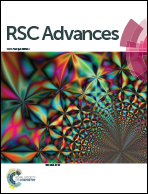Fabrication of a novel tin gas diffusion electrode for electrochemical reduction of carbon dioxide to formic acid†
Abstract
Current gas diffusion electrodes (GDEs) for electrochemical reduction of carbon dioxide to formic acid (ERCF) suffer from poor catalyst utilization or high cost. In this work, we developed a novel Sn GDE (SGDE) consisting of a PTFE-bound gas diffusion layer produced using the rolling-press method and a Nafion-bound catalyst layer synthesised by spraying. The influence of Sn loading, Nafion fraction and electrolytic potential was studied. The results showed that increasing the Sn loading and Nafion fraction in an appropriate range both led to an improvement in ERCF via the increase in the total area of the gas–liquid–solid three phase interface. The shift of the electrolytic potential in the negative direction accelerated ERCF, but shifting too far caused the occurrence of side reactions. The highest Faraday efficiency (72.99 ± 1.91%) and current density (13.45 ± 0.72 mA cm−2) for ERCF were obtained at −1.8 V vs. Ag/AgCl with the SGDE when the Sn loading and Nafion fraction were 5 mg cm−2 and 50 wt%, respectively. This Faraday efficiency is one of the highest values for Sn GDEs under ambient pressure. Moreover, the fabrication cost of the SGDE is low (ca. 80 % m−2). This work indicates the great potential of the SGDE for ERCF in large scale applications.


 Please wait while we load your content...
Please wait while we load your content...